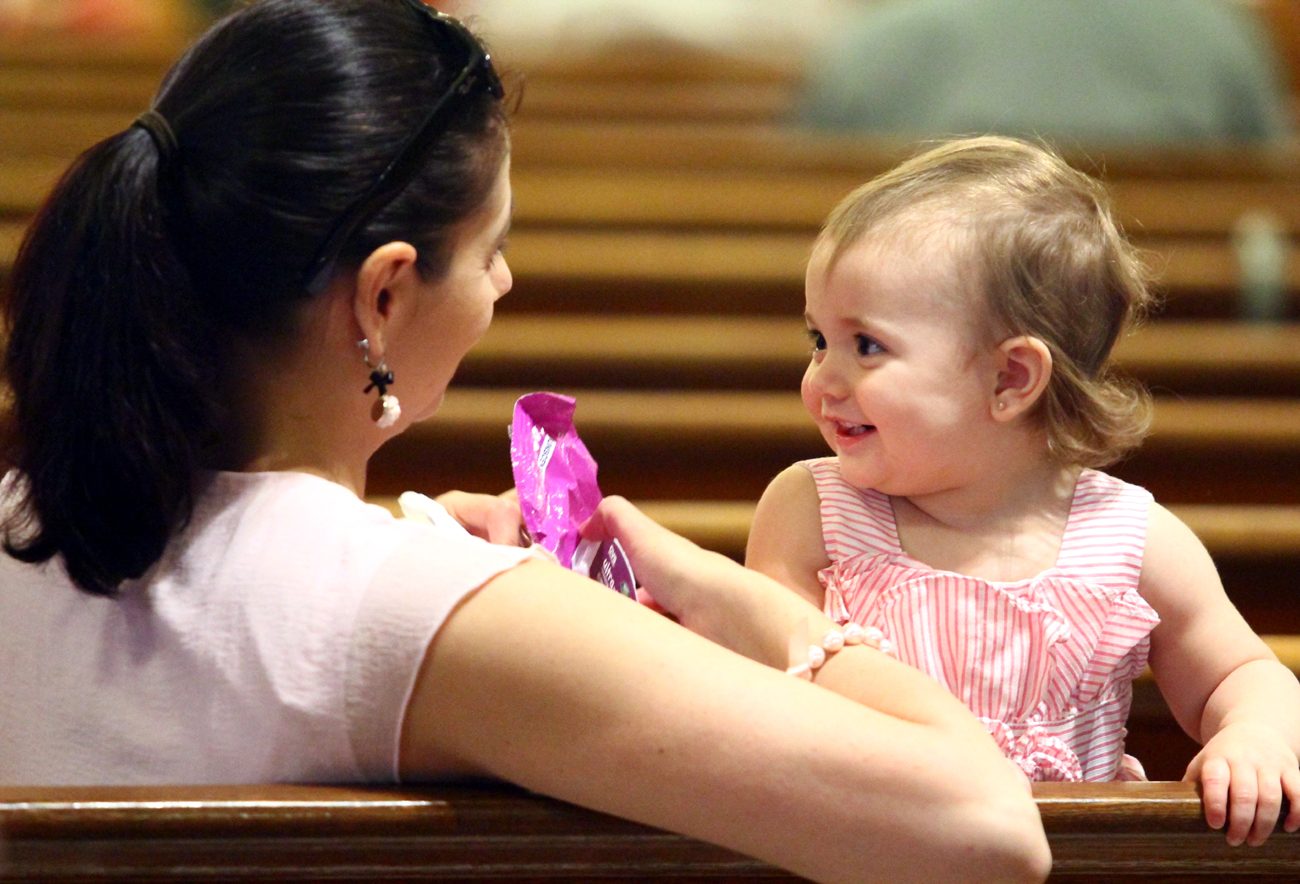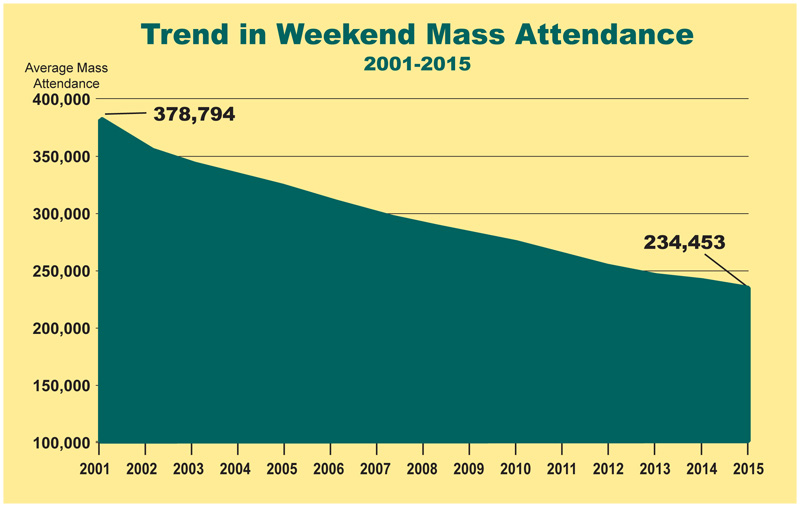The head count of Mass attendance taken in all parishes of the Archdiocese of Philadelphia on the four weekends of October 2015 shows the annual decline that has been reported annually since the mid-1980s may be showing signs of slowing but it has not been halted. Clearly, if there was to be an upward bump in the wake of the visit by Pope Francis to Philadelphia, the previous month, it didn’t happen.
Last year’s figures, by physical count, showed 234,453 worshipers on the average October weekend. This is just 20 percent of the Catholics registered in the parishes, according to annual reports given by the pastors.
The first count, taken in 1982, showed 409,111 worshipers in the churches — as it seemed at the time, a shockingly low 33 percent of the reported registered Catholics. By two years later there was a tiny growth to 410,444, still 33 percent of the registered parishioners.
[hotblock]
The decline since averages out to about 7,500 a year. The greatest decrease in the last decade was 2005-2006 with a 12,607 drop; the lowest recent decrease was 4,524 in 2013-14.
This was followed by decrease of 8,721 in 2013-14 and 5,580 in this most recent year.
While the count is done in an optimum month with generally good weather, the vacation season over and no major holidays, the fluctuations are not easily explained. Obviously rainy October weekends can have an effect in a given year.
Has the clergy scandal affected church attendance? Some polls suggests it has.
What about parish closings? Clearly this is usually done by necessity because the closed parish is in decline and there is a shortage of clergy. But statistics show many parishioners do not join the surviving parish. Are they going to another parish or did they stop going to church?
13,507 Catholics in the archdiocese are attending Sunday evening Masses. “There are changes in family life and work life and (parishes) are adjusting to it,” said a church official.
One small caveat: the October Count does not include those who might be attending Mass at such locations as a college or convent chapel, a monastery, a hospital or nursing home, a military post, prison or other institution. Those numbers, however, would not make a significant difference.
Of course there is good news too. By actual count there were 35 parishes with Mass attendance of 30 percent or more. Sixteen of these parishes were at 40 percent or more. Some have at least a partial explanation. Guest worshipers who are not registered parishioners can help drive up the attendance percentage.
The Cathedral Basilica of SS. Peter and Paul (66 percent), St. John the Evangelist (94 percent) and Old St. Mary’s (44 percent) are in the center city business and historic area with many nonregistered visitors to help fill the pews. The cathedral of course also attracts because it is a cathedral.
Nearby St. Patrick’s (72 percent) also draws visitors, but in addition it is favored by non-registered students and grad students from the University of Pennsylvania and Drexel University, some of whom are young married couples with children.
St. Peter the Apostle (45 percent) has the added attraction of the Shrine of St. John Neumann. St. Rita of Cascia in South Philadelphia (now the Shrine of St. Rita), also favored by pilgrims, posted 42 percent at Mass. Holy Redeemer, with a Chinese congregation, had 45 percent attendance.
[hotblock2]
In the heart of University City, St. Agatha-St. James (206 percent) packs them in. Who says young people don’t go to church? The same can be said for St. Francis de Sales (44 percent) further west of the college campuses.
St. Veronica (312 percent) is a heavily Latino parish in North Philadelphia where most of the people who come are technically in other parishes or have not officially joined (registered in) the parish.
St. Helena (63 percent) in the Olney neighborhood is a dynamic multicultural parish with Masses in English, Spanish and Vietnamese. St. Charles Borromeo, South Philadelphia, is a small but loyal parish at 76 percent. St. Agnes-St. John Nepomucene, a very tiny Slovak parish, had 48 percent attendance through the devotion of its late pastor, Father Francis Lendacky.
St. Colman, Ardmore (43%); St. Cornelius, Chadds Ford (51%); Presentation B.V.M., Wynnewood (48%) and St. Rose of Lima, Eddystone (44%) all buck the odds with high turnout.
St. Andrew in Newtown (40%), the super-parish of the Archdiocese of Philadelphia with 7,968 weekly worshipers, was one of the few parishes to offer both a Saturday evening and Sunday evening Mass.
“That is really a trend,” said Evelyn Brannan Tarpey, associate for pastoral planning with the archdiocesan Office for Parish Service and Support. “Pastors are trying to offer Masses at convenient times for their parishioners.”
At this time, according to the statistics, 13,507 are attending the Sunday evening Masses. “There are changes in family life and work life and they are adjusting to it,” Tarpey said.
For example, it used to be babies were baptized within weeks of birth. Now many couples are waiting until later, Tarpey notes, and parishes should be looking to see the children are baptized when the parents are ready.
Part of that adjustment is looking at the newcomers in the parish. Are they comfortable in English or is there a need for Masses in other languages? Tarpey points to the multitude of Masses offered in other languages with some parishes having three or four different languages.
The 20 percent Mass attendance average posted by the Archdiocese of Philadelphia really isn’t different from the rest of the country, Tarpey said.
But exciting things are happening. Maybe there should be a seminar where pastors and councils of some of these dynamic parishes that are still packing the pews could explain what has worked for them.
PREVIOUS: Knights of Columbus call for nine days of prayer for peace
NEXT: Clergy receive update on sex abuse bill’s status, victim support info





I am a parishioner of St. Rose of Lima Eddystone, PA. In the past, I was a parishioner of Holy Cross in Springfield for 11 years and Sacred Heart for 4 years in Havertown. Fr. Canavan, pastor of St. Rose of Lima, along with Sister Katie have created a wonderful feeling of family. All are welcomed and there is no judgment at St. Rose of Lima. We have learned to trust and laugh once more. The forward thinking of Father Canavan has been inspiring to us all and has brought many back to the church. Father Canavan is a straight shooter — nothing hidden from the parishioners at St. Rose; everything is out on the table and addressed in the Sunday Bulletin.
The number of families and singles has increased tremendously over the past few years and continues. In all my years as a Catholic, I have never experienced the feeling I receive when I am attending Mass at St. Rose of Lima. St. Rose, the parishioners, Father Canavan, and Sister Katie are a breath of fresh air instilling belief and hope. Oh, and let me not forget laughter, lots of laughter. All are welcomed warmly to the Church of St. Rose. It not only ignited my faith once again but also my husband’s and many others.
I was a member of our lady of victory parish for 39 years, you closed that. We were forced to go to rosary which became our lady of the blessed sacrament. I was there for 8 years then you closed that parish and if you think I am happy at st Cyprian Catholic Church you are certainly mistaken. To attend Mass on Sunday and sit there it is just that! When you closed both our parishes you also closed the meaning of having a parish family.
It’s possible that some of the problem is that people move and their former parish doesn’t remove them from the rolls. I know when I lived in the Washington DC area that for a while I was listed in 3 different parishes. The first refused to remove my name from their list because the pastor thought if they lost anyone from such a small parish it might be closed. The second told me I would have to come in and fill out a bunch of forms, which I didn’t have time to do. I eventually received a forwarded letter from them telling me they were going to be stopping by my former residence to talk to me about why I was no longer coming to Mass. The third was where I was actually going. So in that case what looked like a one third attendance rate was really 100% with bad bookkeeping. You might want to keep that in mind.
What are the common denominators in these “dynamic” parishes? Among other things, do they have greater social contact? Schools? What are their demographics: gender, age, education levels, RCIA attendance, etc? Are parents required to attend instruction when their Children are to receive Sacraments Are there programs such as Alpha and active Faith-sharing groups? Is their weekend music different than 10 years ago? Do preachers approach homilies any differently than 10 years ago? Are parishioners surveyed to get a sense of what they need and to show them that their thinking counts?
We also have a great Sunday night Mass 5pm St Isaac Jogues in Wayne Pa very well attended !
Yes, by all means, schedule programs conducted by priests and lay people of the parishes enjoying high attendance to counsel the leaders of the parishes that are struggling on how to raise attendance.
The parishes should also adjust the schedule for confessions. A half hour or forty-five minutes on a Saturday does not do it for people who work Saturday, families, with kids, etc.
Packing the Pews? Are they really catholic or are they just making themselves feel good. I was at Mass where of about 400 people were there and I counted only 4 people did not receive Communion. Of those I would say the average age was about 70. The others MUST have all been in the state of GRACE!!! I wonder why they all went to communion when the previous 2 weeks that I went to Confession there were less that 15 people at confession from beginning to end. I guess no one commits serious sin anymore!!!!!
The REAL fact is most don’t care it’s like going up to get a NECCO wafer. And of course the priest never mentions that Birth control is a serious sin> Since catholic births are way down over 50 years I guess young married couples are not having SEX!!!!!
Wow, that is an awful lot of judgment for one person to carry.